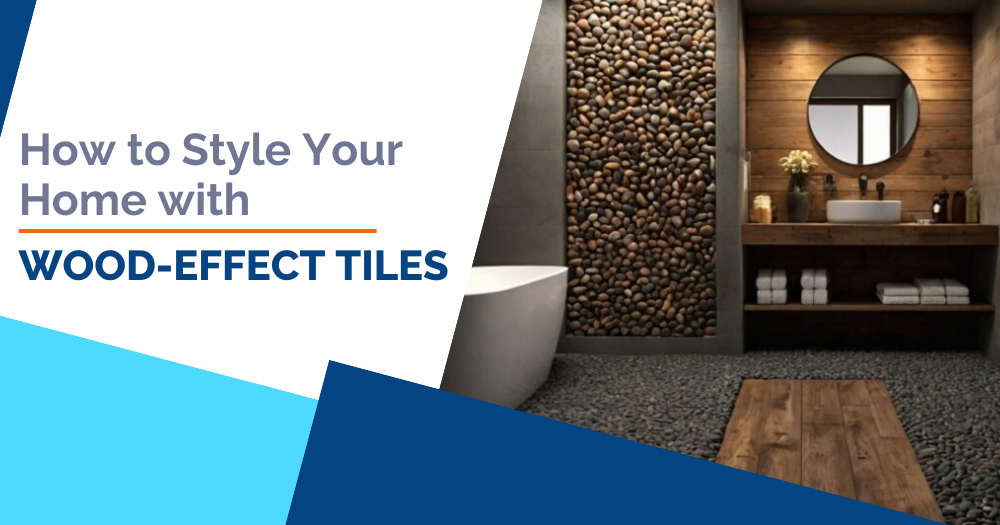Wood-effect tiles have become one of the most sought-after flooring options in recent years, and for good reason. Combining the timeless beauty of wood with the practicality of ceramic or porcelain, these tiles offer a durable, low-maintenance, and versatile solution for any room in your home. Whether you're renovating your bathroom, kitchen, living room, or outdoor space, wood-effect tiles can completely transform your living environment.
This guide will walk you through everything you need to know about styling your home with wood-effect tiles. From understanding their benefits to selecting the right type for your space, we’ll cover a range of tips, design ideas, and room-specific advice.
What Are Wood-Effect Tiles?
Before diving into styling, it's important to understand exactly what wood-effect tiles are. As the name suggests, wood-effect tiles are ceramic or porcelain tiles designed to mimic the appearance of natural wood. These tiles are created using advanced printing technology to replicate the natural textures, grains, and colors found in real wood, offering the aesthetic of wood without the maintenance challenges.
Wood-effect tiles are available in various sizes, textures, and finishes, making them a versatile option for different types of interiors. Whether you prefer the rustic appeal of oak, the modern look of walnut, or the light, airy feel of maple, there’s a wood-effect tile that can match your vision.
Why Choose Wood-Effect Tiles?
There are several reasons why wood-effect tiles are an excellent choice for any home. Let's explore some of the key benefits:
1. Durability and Longevity
Unlike real wood, which can warp, scratch, or fade over time, wood-effect tiles are highly durable and long-lasting. Porcelain, in particular, is resistant to moisture, stains, and scratches, making it ideal for high-traffic areas like kitchens and bathrooms. Wood-effect tiles can withstand heavy foot traffic, spills, and even the wear and tear caused by pets and children.
2. Easy Maintenance
Wood-effect tiles require far less maintenance than natural wood floors. While wooden floors need regular polishing, sanding, and sealing, wood-effect tiles only need routine cleaning. Sweep or vacuum regularly to remove dirt and debris, and mop occasionally with a gentle cleaner to keep them looking fresh.
3. Moisture Resistance
One of the main challenges of using real wood in areas with high humidity, such as bathrooms or kitchens, is the risk of water damage. Wood-effect tiles, on the other hand, are moisture-resistant, making them an excellent choice for wet environments. They won't swell, warp, or degrade when exposed to water.
4. Cost-Effective
Natural wood flooring can be quite expensive, especially when you factor in the installation costs. Wood-effect tiles offer a more affordable alternative without sacrificing the appearance of real wood. Additionally, because they’re low-maintenance, they save you money in the long run.
5. Versatility
Wood-effect tiles are incredibly versatile. Available in a range of colors, textures, and finishes, they can complement a variety of home décor styles, from traditional to contemporary. Whether you're aiming for a rustic farmhouse aesthetic or a sleek, modern look, wood-effect tiles can help you achieve the desired effect.
Types of Wood-Effect Tiles
Wood-effect tiles come in different materials, finishes, and styles. Understanding these options will help you choose the right tiles for your space.
1. Porcelain Wood-Effect Tiles
Porcelain wood-effect tiles are a popular choice due to their strength and moisture resistance. Made from a denser material, porcelain is a great option for areas that experience a lot of traffic, like hallways, living rooms, or kitchens. These tiles come in various designs, from rustic reclaimed wood looks to smooth, modern finishes.
2. Ceramic Wood-Effect Tiles
Ceramic wood-effect tiles are slightly more affordable than porcelain but still offer durability and an attractive finish. They are ideal for dry spaces, such as bedrooms or living rooms, where moisture isn’t a concern. Ceramic tiles are also available in a wide variety of wood finishes, giving you plenty of design options.
3. Textured Wood-Effect Tiles
Textured wood-effect tiles replicate the tactile feel of real wood with raised grain patterns. These tiles are perfect for creating a rustic or country-style interior. The textured surface adds an authentic touch and is also slip-resistant, making them a good choice for kitchens and bathrooms.
4. Glossy vs. Matte Wood-Effect Tiles
The finish of your wood-effect tiles can greatly impact the overall aesthetic of your room. Glossy wood-effect tiles reflect light and have a sleek, modern appearance. They’re perfect for smaller rooms, as they make spaces look larger. On the other hand, matte wood-effect tiles offer a more subdued, natural appearance, ideal for a more rustic or cozy look.
How to Style Your Home with Wood-Effect Tiles
Now that you have a better understanding of wood-effect tiles, let’s explore how you can incorporate them into different rooms in your home.
1. Living Room
The living room is one of the most important areas in your home, and it’s where you’ll likely spend a lot of time with family and guests. Wood-effect tiles can add warmth and texture to the room, whether you prefer a contemporary, classic, or rustic aesthetic.
-
Modern Look: For a contemporary living room, go for long, narrow wood-effect tiles with a smooth, glossy finish. Opt for light oak or maple shades to create an airy, open feel. These tiles can be paired with sleek furniture, neutral-colored walls, and pops of color through artwork or throw pillows.
-
Rustic Look: If you love a more rustic or farmhouse style, opt for textured wood-effect tiles that replicate the appearance of reclaimed wood. These tiles often have more pronounced grain patterns, adding character and charm to your living space. Pair these with vintage or farmhouse-style furniture for a cozy, welcoming feel.
-
Herringbone Pattern: Consider laying your wood-effect tiles in a herringbone or chevron pattern for added visual interest. This design is timeless and brings an elegant touch to any living room.
2. Kitchen
The kitchen is one of the busiest areas in your home, and it’s also where you need durable, easy-to-clean flooring. Wood-effect tiles are a perfect fit for this space, offering both style and functionality.
-
Rustic Farmhouse: For a rustic kitchen, choose warm-toned wood-effect tiles like oak or walnut. These can be paired with open shelving, vintage-inspired appliances, and natural stone countertops. Consider using a patterned backsplash to add depth and texture.
-
Modern Kitchen: If you have a modern kitchen, opt for sleek, straight-edged wood-effect tiles in neutral tones. Light-colored wood-effect tiles will make the space feel larger, while dark tiles will give your kitchen a bold, contemporary look.
-
Mixed Materials: Consider mixing wood-effect tiles with other materials, such as stone or concrete, to create a dynamic design. For example, you could use wood-effect tiles for the flooring and stone tiles for the backsplash.
3. Bathroom
Bathrooms are often prone to high humidity, which can be detrimental to real wood flooring. Wood-effect tiles are an ideal solution for bathrooms, offering the look of wood without the maintenance concerns.
-
Spa-Like Retreat: Use light-colored wood-effect tiles in a matte finish to create a serene, spa-like atmosphere in your bathroom. Combine these tiles with marble countertops, glass shower enclosures, and soft, neutral-toned towels.
-
Dark and Dramatic: For a more dramatic look, dark wood tiles in a glossy finish can create a chic, luxurious bathroom. Pair these with metallic fixtures, a freestanding bathtub, and dark-colored cabinetry for a bold design.
-
Wood Accent Walls: You don’t have to limit wood-effect tiles to the floor – consider using them on your bathroom walls as well. A wood-effect accent wall can add warmth and texture, especially when paired with clean, white fixtures.
4. Hallways and Entryways
Wood-effect tiles are perfect for high-traffic areas like hallways and entryways, where they can withstand heavy foot traffic while creating a welcoming atmosphere.
-
Light Tones: For a bright, airy entryway, choose light wood-effect tiles in shades like pale oak or ash. These tiles will make the space feel open and inviting, especially when paired with neutral-colored walls and minimalist décor.
-
Dark Tones: Darker wood-effect tiles, such as walnut or espresso, can give your hallway a more sophisticated, dramatic look. These tiles work well with bold colors, like deep blues or rich greens, and will add a touch of luxury to your entryway.
Conclusion
Wood tiles offer a beautiful and practical solution for homeowners looking to achieve the timeless beauty of wood without the associated maintenance and costs. With a variety of finishes, colors, and patterns to choose from, these tiles can be used in virtually any room to create a stylish and functional space. Whether you're updating your kitchen, living room, bathroom, or hallway, wood-effect tiles will help you achieve the look you desire with ease.
For more information on how to style your home with wood-effect tiles or to explore our wide selection of high-quality options, visit Pebble Tile Shop.
Original Content Source - https://www.pebbletileshop.com/blogs/news/how-to-style-your-home-with-wood-effect-tiles







